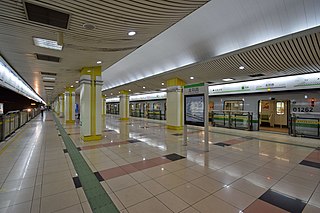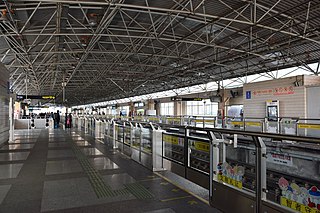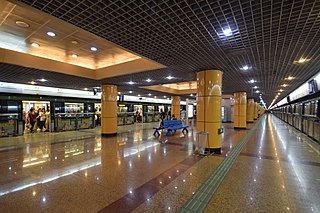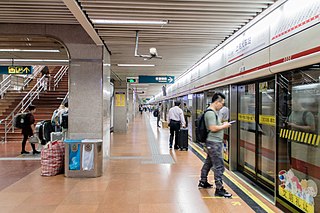
Changshu Road is an interchange station between lines 1 and 7 of the Shanghai Metro. It is situated in Shanghai's Xuhui District, within the inner ring-road. Furthermore, it provides access to the shopping street Huaihai Road, Shanghai Conservatory of Music as well as the former colonial neighborhood previously called The French Concession.

Jiangsu Road is the name of a station on lines 2 and 11 of the Shanghai Metro. This is one of the stations that can refund the 20RMB deposit for the Shanghai Public Transportation Card.

Dongchang Road is a station on Shanghai Metro Line 2. It is part of the initial Zhongshan Park to Longyang Road section of Line 2 that opened on 20 September 1999.

Longyang Road is an interchange station that serves both the Shanghai maglev train and lines 2, 7, 16 and 18 on the Shanghai Metro. It provides quick transfers between the metro system and the Maglev train to and from Pudong International Airport. There are two separate fare-paid zones at this station: one for the conventional metro lines and one for the Maglev train, which has a separate fare system. It is also the third four-line interchange station in mainland China and the second in Shanghai, after Century Avenue and Chegongmiao in Shenzhen, and the first five-line interchange station in Shanghai and mainland China.

Caoyang Road is an interchange station between lines 3, 4, 11 and 14 of the Shanghai Metro, and is located in Putuo District.

Yishan Road is the name of an interchange station between Lines 3, 4 and 9 on the Shanghai Metro. It is the southernmost station shared by Line 3 and Line 4, although the two lines do not share tracks.

Hongqiao Road is an interchange station between Lines 3, 4 and 10 on the Shanghai Metro. It is the southernmost station of which Lines 3 and 4 share the same tracks. The station opened on 26 December 2000 as part of the initial section of Line 3 from Shanghai South Railway Station to Jiangwan Town, and Line 4 service began here on the final day of 2005. The interchange with Line 10 opened on 10 April 2010.

Zhenping Road is the name of an interchange station on the Shanghai Metro. It serves Lines 3, 4 and 7. The station typically handles 108,000 passengers on weekdays.

East Nanjing Road is an interchange station between Lines 2 and 10 on the Shanghai Metro. It is located in Huangpu District, under the intersection of Nanjing Road (E.) and Henan Road (M.) in the city center of Shanghai.

Zhongshan Park is the name of an interchange station between Lines 2, 3 and 4 on the Shanghai Metro, named after Shanghai's largest commercial park which is located nearby. This station served as the western terminus of Line 2 from the line's opening on 20 September 1999 until the first westward extension to Songhong Road opened on 30 December 2006. The interchanges with Lines 3 and 4 opened on 27 December 2000 and the final day of 2005, respectively, and are part of both lines' initial sections. Immediately to the northeast of the station is the Cloud Nine shopping mall, visible from the elevated Lines 3 and 4.

Jing'an Temple is the name of an interchange station between Lines 2, 7 and 14 of the Shanghai Metro. This station is located in Jing'an District, below the historic Jing'an Temple and the Jiu Guang shopping mall. It is part of the initial section of Line 2 that opened from Zhongshan Park to Longyang Road that opened on 20 September 1999; the interchange with line 7 opened on 5 December 2009 as part of that line's initial section between Shanghai University and Huamu Road and the interchange with line 14 opened on 30 December 2021.

Shanghai Railway Station is an interchange station between lines 1, 3 and 4 on the Shanghai Metro. It is one of the stations where Line 3 and Line 4 share the same tracks and elevated platforms.
First generation trams in Shanghai began operating in 1908 using a steel wheeled electric system until the last was closed in December 1, 1975. The last operating tram line in Shanghai was No. 3, which ran from Hongkou Park to Jiangwan Wujiaochang. It was dismantled in 1975, and replaced by the 93 bus. In the early days of operation, tram cars were partitioned to provide first- and second-class seating. Some trams, principally for the Chinese workers, were designated as third-class.

The former residence of Soong Ching Ling is a museum in the Shichahai area of Beijing, China, and once was the last residence of Soong Ching-ling, the wife of Sun Yat-sen and later Vice-President and Honorary President of the People's Republic of China in 1981. The museum opened in 1982, while it was listed as a National Key Cultural Relic Protection Unit. It was renovated in 2009, and is dedicated to her memory.

Longhua Pagoda (龙华塔) is an octagonal wood and brick pagoda located in Xuhui District, Shanghai, East China. It is thought to have been first built during the Three Kingdoms period, but the existing tower structure was built during the Northern Song dynasty. The pagoda underwent several renovations over various dynastic periods, which resulted in the addition of several architectural features that were not in the typical style of the Song dynasty. After the establishment of the People's Republic of China, these later additions were removed and rebuilt in the Song dynasty style. Because of this, the pagoda has now been largely restored to its original appearance. The pagoda was twice established as a Shanghai Cultural Site Under State Protection, once on 26 May 1959 and again on 7 December 1997. On 25 May 2006, it was declared by the State Council to be among the sixth group of Major Historical and Cultural Sites Protected at the National Level.

Haipai cuisine is a Western-style cooking that is unique to Shanghai, China. It absorbs the traditions of several cuisines from other regions of China and of Western cooking, adapting them to suit the local taste according to the features of local ingredients. It is divided into several major types: French, Italian, Russian, British, and German, among which the Russian-type dishes, such as the Shanghai-style borscht, receive a great welcome as they are more affordable. Today, the most famous dishes of Haipai cuisine are luó sòng tāng, fried pork chops, and Shanghai salad. Apart from the above-mentioned common dishes, baked clams, baked crabs, and jin bi duo soup are also popular among the Haipai dishes.

Songpu Bridge, first known as Huangpu River Bridge, Cheting Bridge, is the first bridge built across the Huangpu River in Shanghai, China. It is a double-layer steel truss bridge for highway and railway across the Huangpu River in Songjiang District. The Songpu Bridge Railway Bridge and Highway Bridge were opened to traffic on September 11, 1975 and June 29, 1976, respectively. For a long time after its completion, it was also the only bridge on the upper reaches of the Huangpu River until the opening of the Huangpu River Bridge on the G15 Shenhai Expressway in 2006.

The tomb of Lu Xun is the burial place of the Chinese writer Lu Xun (1881–1936), located in the northwestern corner of the Lu Xun Park in Hongkou District, Shanghai. Covering an area of 1,600 square metres (17,000 sq ft), the tomb of Lu Xun was built in 1956, and in the same year, the remains of Lu Xun was moved to this tomb from the Wanguo Cemetery of Shanghai.

The Songjiang Tang Sutra Building, also known as Songjiang Tang Dynasty Dharana Sutra Stone Building, is located in the Zhongshan Primary School, Songjiang District, Shanghai, People's Republic of China, the oldest surviving above-ground relic in Shanghai, built in 859 AD. Since then, it has tilted due to age and weathering, and was restored in 1963.On January 13, 1988, it was announced as a national key cultural relic protection unit.

The tomb of Xu Guangqi is the burial site of Xu Guangqi, a prominent late Ming dynasty statesman, scholar, and leader of the Catholic community, as well as some of his relatives. It is located north of Xujiahui, Shanghai, in the present-day Guangqi Park, covering an area of 3,000 square meters and standing 2.2 meters tall. The tomb is elliptical in shape.




















